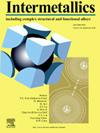Enhanced strength-ductility synergy in CrFe2Ni2Ti0.2 high-entropy alloys by metalloid element Si and solution-aging treatment
IF 4.3
2区 材料科学
Q2 CHEMISTRY, PHYSICAL
引用次数: 0
Abstract
Solution-aging treatment is a critical approach for optimizing the mechanical properties of HEAs. In this study, CrFe2Ni2Ti0.2Six (x = 0, 0.125, 0.25, 0.375, 0.5, 0.625, denoted as Six) HEAs are prepared by vacuum arc melting, and all the HEAs are subjected to aging treatment at 800 °C according to phase diagram calculations (CALPHAD). The phase composition, microstructure and mechanical properties of the alloys are systematically investigated. CALPHAD predictions and experimental results reveal that Si addition (x = 0.325, 0.5, 0.625) promotes the formation of a dual-phase structure comprising an FCC and G-phase (Ni16Ti6Si7). And the two-phase hybrid structure of the alloys exhibits a labyrinth-like shape. Particularly, the Si0.375 alloys exhibit optimal strength-ductility synergy among the considered alloys, achieving an ultimate strength of 1325.2 MPa while maintaining a ductility of 37.3 %. This represents a 67 % improvement in yield strength compared to the as-cast alloys. The fracture surface of the Si0.375 alloys exhibit characteristic dimples of varying sizes, indicating a predominantly ductile fracture mechanism. Moreover, heat treatment significantly increases the G-phase volume fraction, thereby enhancing both grain boundary and precipitation strengthening effects.
类金属元素Si和固溶时效处理增强CrFe2Ni2Ti0.2高熵合金的强度-塑性协同效应
固溶时效处理是优化HEAs力学性能的重要手段。本研究采用真空电弧熔炼法制备了crfe2ni2ti0.2 .6 (x = 0, 0.125, 0.25, 0.375, 0.5, 0.625,记为6)HEAs,并根据相图计算(CALPHAD)在800℃下进行时效处理。系统地研究了合金的相组成、显微组织和力学性能。CALPHAD预测和实验结果表明,Si的加入(x = 0.325, 0.5, 0.625)促进了FCC和g相(Ni16Ti6Si7)双相结构的形成。合金的两相杂化结构呈迷宫状。特别是Si0.375合金表现出最佳的强度-塑性协同效应,达到了1325.2 MPa的极限强度,同时保持了37.3%的塑性。与铸态合金相比,屈服强度提高了67%。Si0.375合金断口呈现不同大小的韧窝特征,表明断裂机制以韧性为主。此外,热处理显著增加了g相体积分数,从而增强了晶界和析出强化效果。
本文章由计算机程序翻译,如有差异,请以英文原文为准。
求助全文
约1分钟内获得全文
求助全文
来源期刊

Intermetallics
工程技术-材料科学:综合
CiteScore
7.80
自引率
9.10%
发文量
291
审稿时长
37 days
期刊介绍:
This journal is a platform for publishing innovative research and overviews for advancing our understanding of the structure, property, and functionality of complex metallic alloys, including intermetallics, metallic glasses, and high entropy alloys.
The journal reports the science and engineering of metallic materials in the following aspects:
Theories and experiments which address the relationship between property and structure in all length scales.
Physical modeling and numerical simulations which provide a comprehensive understanding of experimental observations.
Stimulated methodologies to characterize the structure and chemistry of materials that correlate the properties.
Technological applications resulting from the understanding of property-structure relationship in materials.
Novel and cutting-edge results warranting rapid communication.
The journal also publishes special issues on selected topics and overviews by invitation only.
 求助内容:
求助内容: 应助结果提醒方式:
应助结果提醒方式:


